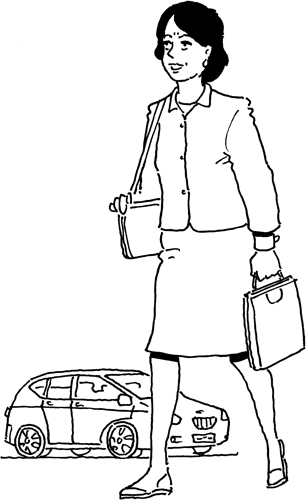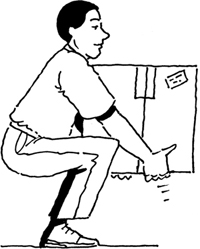
Diana Moran
So, now we know why activity is important, I say, ‘Sod sitting – get moving!’, right away.
As Muir says in his introduction, being fit is a necessity, not just an option. Your individual level of fitness will depend on your personal lifestyle, interests and the commitment you have to looking after your health. Fitness is all about being able to do the things you want when you want to. We all need to do what we can to help ourselves maintain physical independence, and one significant but simple way is by including more activity in our everyday lives. The earlier you develop good habits, the more benefit you’ll feel as the years roll past.
So make the opportunity to be more active, and take it, anytime, anywhere and in any way.
Try to take more regular moderate exercise, and persuade your friends or family to join you. Start with simple things, like taking the dog for a walk or using the stairs instead of the lifts. Or try walking to work or the shops or to school instead of taking the car. Then you can look forward to enjoying many more years of ACTIVE life. The trick is to do an activity that gives you pleasure. You will then discover that being active actually boosts your energy levels. When we exercise, the body releases chemicals called endorphins which give us a ‘feel-good’ factor as the circulation gets going, improving our heart and lung efficiency. Exercise and being active makes your complexion glow and your mind more alert. As we’ve seen, being inactive is a major risk as we get older. Both Muir and I say – ‘down with sofas and up with stairs’. Walking is our prescription for good health. Do it with others and help others do it.

Brisk walking
• Lessens the risk of heart disease
• Encourages more oxygen into your lungs
• Improves your cardio-vascular system
• Is ‘weight bearing’ (body weight is supported by spine, legs and feet)
• Builds healthy bones
• Builds strong leg muscles – vital for physical independence.
• Can be both sociable and beneficial – especially if you have a partner to walk with
How can fitness improve your health?
Physical fitness has five components:
1. Cardio-vascular fitness
2. Muscular strength
3. Muscular endurance
4. Flexibility
5. Motor fitness
Cardio-vascular fitness provides us with stamina. Good stamina enables you to sustain free bodily movement for the length of time you need it without leaving you feeling puffed, exhausted or faint. To achieve good stamina, you must aim to do enough regular activity in order to boost the efficiency of your heart and lungs, and improve your circulation and digestion.
Work on your cardio-vascular fitness by doing aerobic exercises (aerobic exercises simply mean exercising with air). Examples of these types of exercises are:
• Exercises to music (such as line dancing or ballroom dancing)
• Jogging
• Brisk walking
Whichever aerobic exercise or activity you choose, you need to sustain it for a length of time in order to gain benefit. Thirty minutes is an ideal time, but do take age and ability into account. All aerobic activities will make your heart (which itself is a muscle) pump just that little bit harder, and this has the effect of making your lungs work more efficiently, utilising the oxygen you breathe in and improving your circulation. It’s important to breathe deeply in order to encourage greater oxygen intake and lung elasticity. Aerobic exercises make you feel warm and puff a bit, but you should still be able to talk while you’re doing them!

The second component of physical fitness is muscular strength. This is the ability of a muscle to exert maximum force to overcome a resistance. This simply means being able to do things like twisting the stubborn top off a jar of marmalade, or being able to pick up a particularly heavy object. Your body needs strong muscles in order to maintain good posture and improve your shape. As the years advance, it’s paramount to keep leg muscles strong. I’d suggest concentrating on strengthening the front thigh muscles (quadriceps) to maintain your physical mobility. Simple regular brisk walking involves the rhythmic movement of both muscles and joints, and will stop the muscles atrophying.
To be physically fit you also need muscular endurance. This is the ability of a muscle (or group of muscles) to exert force, in order to overcome a resistance, for an extended period of time. In other words, you need strong muscles to make light work of everyday chores. Those occasions when you have to push yourself just that little bit harder, or exert a little more strength for longer periods than you want, in order to achieve. How many times have I wanted to drop my heavy shopping bags in the supermarket car park just because I have stupidly forgotten where I parked the car? Situations like this call for muscular endurance, and one has to keep on walking and looking. What a relief to finally find the car and be able to put the bags down. If you have well-toned, strong muscles, you reduce the risk of tearing ligaments or damaging yourself when pushed to the limits or if you have a fall.
The next component of physical fitness is flexibility. Being flexible enables you to put your muscles and joints through their full range of movements with ease. We take this flexibility or suppleness for granted when we are young, but you need to work at it as you get older. It’s a great feeling to be able to use your body efficiently to bend down to do up your shoelaces, to stretch up to high shelves and to use your body to its full potential.

Stretching exercises should be performed before and after an exercise session or physical activity, such as gardening, jogging or playing tennis, in order to prevent injury. When you finish being active your muscles are warm, so it’s safe to stretch them out just that little bit more, in order to increase your flexibility and suppleness. Do it at the end of a brisk walk – and surprise yourself by finding you are suppler and able to reach parts you couldn’t reach before.
Finally, there’s motor fitness, which governs your skill and ability to control movements, balance, speed, co-ordination and agility. It gives you the capacity to react quickly, and the confidence to move about without fear of falling over. With skill and the natural co-ordination of mind and body working together you can make your movements graceful, effective and efficient.
If you work hard on all five components of your physical fitness, there is a good chance of maintaining your physical independence long into later life. The benefits to your general health and well-being are enormous and will give you the opportunity to live a full life. In order to maintain your physical fitness, make exercise a natural part of every day. Try to be generally more active: walk more, climb stairs, cycle, dance, swim and garden. Moderate exercise CAN help enhance and maintain your quality of life. But there are no quick fixes for a healthy lifestyle, just two simple rules: be more active and eat sensibly.
